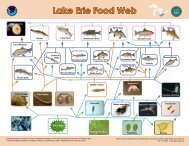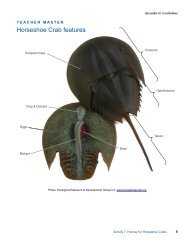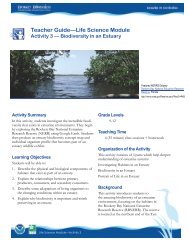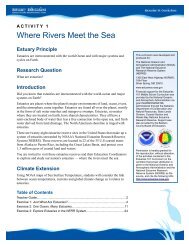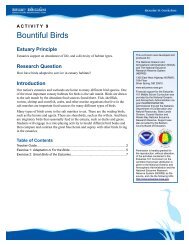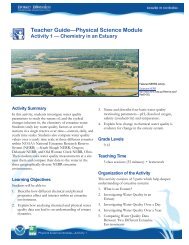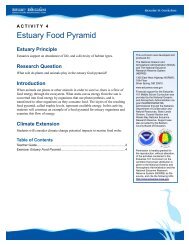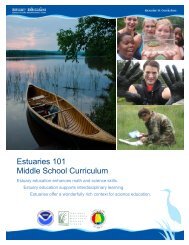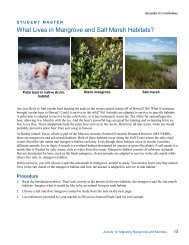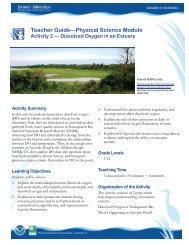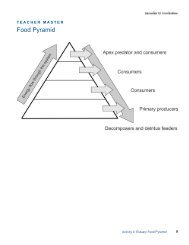Teacher GuideâEarth Science Module - Estuaries NOAA
Teacher GuideâEarth Science Module - Estuaries NOAA
Teacher GuideâEarth Science Module - Estuaries NOAA
You also want an ePaper? Increase the reach of your titles
YUMPU automatically turns print PDFs into web optimized ePapers that Google loves.
Federal Point to the north, Smith Island to the south,the Atlantic Ocean to the east, and the Cape Fear Riverto the west. The lagoon-like complex at the Zeke’sIsland site is one of the most unusual areas of the NorthCarolina coast. There are three main islands within thecomponent of the reserve—Zeke’s Island covering 42acres of high ground, North Island encompassing 138upland acres, No Name Island covering about threeacres, and the beach barrier spit of 64 acres. The islandsare fringed with extensive marshes and tidal flats.Habitat and communities in the reserve include tidalflats, intertidal salt marshes, supratidal salt marshes,shrub thicket, maritime forest, dune areas, sandy beach,and rock jetty.Zeke’s Island is part of the lower Cape Fear region, anarea whose outstanding estuarine and ocean resourceshave long-supported an important commercial fishingindustry. The Cape Fear estuary drains the largest watershedin North Carolina, containing 27 percent of thestate's population. The Cape Fear River itself (about 320km in length) is formed in the Piedmont province by theconfluence of the Haw and Deep Rivers in ChathamCounty. Two tributaries join it just upstream ofWilmington, the Black River and the Northeast CapeFear River. The Black River drainage represents about17 percent of the Cape Fear drainage system and theNortheast Cape Fear River about 18 percent. (Adaptedfrom the North Carolina NERR site.)PreparationDownload Google Earth and install it on yourclassroom computer(s) or computer lab machines. Tofind a tutorial for using Google Earth, please read thebox below.Google EarthThis activity requires the use of Google Earth.If students have computer access, the use of GoogleEarth (http://earth.google.com/) can help themdevelop spatial skills.To find the Tutorial “Using Google Earth to Explore<strong>Estuaries</strong>” go to <strong>Estuaries</strong>.noaa.gov, click the tab titledCurriculum and then the sub-tab titled Tutorials.MaterialsStudentsNeed to work in a computer lab or with acomputer and projectorCopy of Student Worksheet — Extreme Weatherin an Estuary.Copy of Student Reading — Extreme Weatherin an Estuary.Copy of Student Data Sheet 1 — Which NERRsAre Affected by Hurricanes?Copy of Student Worksheet — Extreme Weatherin an Estuary.<strong>Teacher</strong>sBookmark the following sites:http://nerrs.noaa.gov/Reserve.aspx?ResID=NOChttp://www.nasa.gov/vision/earth/lookingatearth/2005hurricane_recap.htmlDownload Google Earth.If you don't want to use Google Earth, supplytopographic and road maps of the area tostudents instead.Equipment:Computer lab orComputer and ProjectorCopy of Student Data Sheet 2 — Impact on anEstuary by an Extreme Weather Event.Copy of Using Google Earth to Explore<strong>Estuaries</strong>Earth <strong>Science</strong> <strong>Module</strong>—Activity 42



